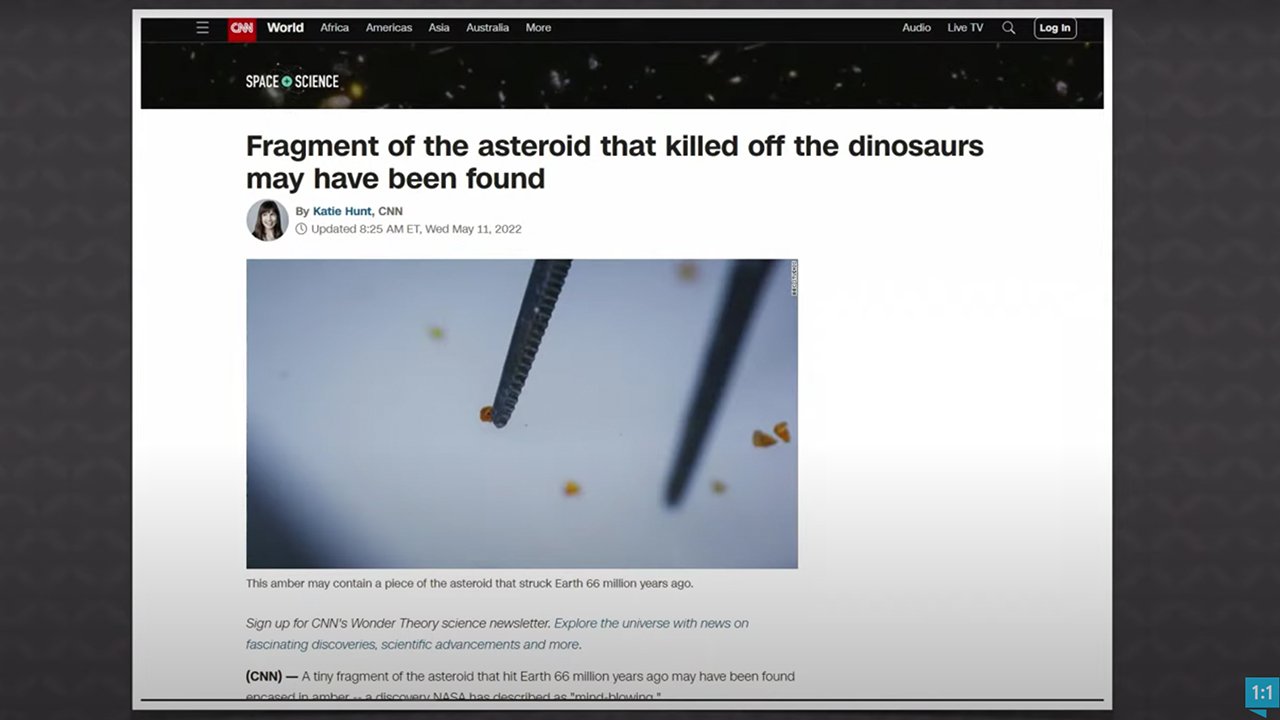
Fragment of “Dino-Killing Asteroid” Discovered in Amber
According to a popular evolutionary story, 66 million years ago an asteroid hit earth, forming a massive crater off the coast of Mexico and starting a chain of events including acid rain, massive wildfires, earthquakes, and tsunamis that eventually caused the extinction of the dinosaurs. And scientists may now have discovered bits of this asteroid, encased in amber.
All of these findings point to a massive catastrophe—but what was the catastrophe?
In yet-to-be-published research (so these claims have not undergone peer-review yet), researchers claim they’ve discovered minuscule bits of asteroid that were trapped in sticky tree sap in the Hell Creek Formation in North Dakota. This extraordinary fossil site is also the home of a variety of other remarkable findings, including fish with volcanic glass in their gills, an impaled turtle, a dinosaur leg with skin intact, and a fossilized pterosaur egg. All of these findings point to a massive catastrophe—but what was the catastrophe?
Well, the data is overwhelming that a 7.5-mile-wide asteroid did strike earth and form the Chicxulub cater sometime in the past. Based on the geologic evidence, it appears this asteroid struck earth during the flood, adding to the cataclysmic judgment on the wicked world of that time. Geologist Dr. Andrew Snelling explains:
This news item has been current news for over three years due to the widespread publicity about the research at this Tanis site in North Dakota. Of course, such publicity is designed to give the researchers notoriety and thus a higher academic profile. Nevertheless, the research of this evidence of a cataclysmic burial is of interest to us as part of our understanding of the Flood event.
This burial site gives testimony to the devastating effects of the asteroid impact that occurred at Chicxulub on the edge of the Yucatan peninsula in Mexico more than 2,000 miles away. The resulting debris was scattered so widely that it impacted the critters at this Tanis location in North Dakota, causing their instant demise and burial. Fish killed with volcanic glass shards in their gills, a fossilized pterosaur egg, and an exceptionally preserved dinosaur leg with skin intact (obviously ripped off the animal by the explosive ash cloud reaching this site) spectacularly document that these animals died and were buried within hours of the asteroid impact, before any decay could have occurred. Also, the claimed fragments of the asteroid found in amber (fossilized tree resin) is stunning, but not unexpected in such a globally cataclysmic event. We await further documentation.
These evolutionary paleontologists consider this event as marking the extinction of the dinosaurs after their millions-of-years reign on the earth. However, it is instead a stunning example of what was occurring during the flood as God destroyed the old world by the global flood judgment. This asteroid impact was merely one of many devastating “snapshots” during the flood cataclysm when the destruction of life and the earth was occurring hour by hour for a full year only about 4,500 years ago. The detailed documentation this research team is providing is top-class and worth noting and using as we apply it to the flood cataclysm. It demonstrates the necessity of a recent catastrophic burial for these fossils for them to be so well preserved.
As Dr. Snelling notes, the catastrophic burial and preservation of soft tissues in fossils point to a watery catastrophe at the same time as the asteroid impact that could rapidly bury these creatures. Paleontologist Dr. Gabriela Haynes provides more details:
It is fascinating that the researchers involved in the study admit and understand that a quick burial must have happened, based on the features of the fossil record from the area:
- Thousands of fish fossils found together, and one of the secular researchers involved in the study believes they were buried alive
- An impaled turtle
- A dinosaur leg (of Thescelosaurus) perfectly preserved, with skin and more soft tissue present
- No time for decay since the fossil material is very well preserved.
All of this evidence points to a catastrophic event with a massive amount of water involving sea creatures and land animals (fishes, a turtle, and a dinosaur). Rapid burial is one of the first conditions for an organism to be fossilized, and all of these characteristics—including the mass mortality of the thousands of fish and their being buried alive—demonstrate evidence of rapid burial. These are all the same characteristics we should find if the global flood cataclysm as described in Genesis really occurred.
The preservation of the material also confirms rapid burial that happened a few thousands of years ago, not millions of years ago.
In other words, this isn’t evidence for a dinosaur extinction millions of years ago. It’s just more evidence of God’s global judgment on sin just 4,300 years ago. Now that’s a very different account than what the secularists are claiming!
Get More Answers on Answers News
I discussed this item yesterday on Answers News with cohosts Dr. Kaia Kloster and Rob Webb. Answers News is our twice-weekly news program filmed live before a studio audience and broadcast on my Facebook page and the Answers in Genesis Facebook page. We also covered the following topics:
- Bacteria that can play tic-tac-toe?
- Students charged with “sexual harassment” for not using preferred pronouns.
- Most US parents of young children don’t believe in Jesus.
- And more!
Be sure to join us each Monday and Wednesday at 2 p.m. (ET) on my Facebook page or the Answers in Genesis Facebook page for Answers News. You won’t want to miss this unique news program that gives science and culture news from a distinctly biblical and Christian perspective.
Thanks for stopping by and thanks for praying,
Ken
This item was written with the assistance of AiG’s research team.
Most Recent News
-
Dec. 18, 2025 from Ken Ham Blog
New data suggests IVF embryo deaths now exceed abortion totals, meaning abortion is no longer the leading cause of death in the US.
-
Dec. 15, 2025 from Ken Ham Blog
Are tomatoes “de-evolving” on the remote Galápagos islands?

Answers in Genesis is an apologetics ministry, dedicated to helping Christians defend their faith and proclaim the good news of Jesus Christ.
- Customer Service 800.778.3390
- Available Monday–Friday | 9 AM–5 PM ET
- © 2025 Answers in Genesis



